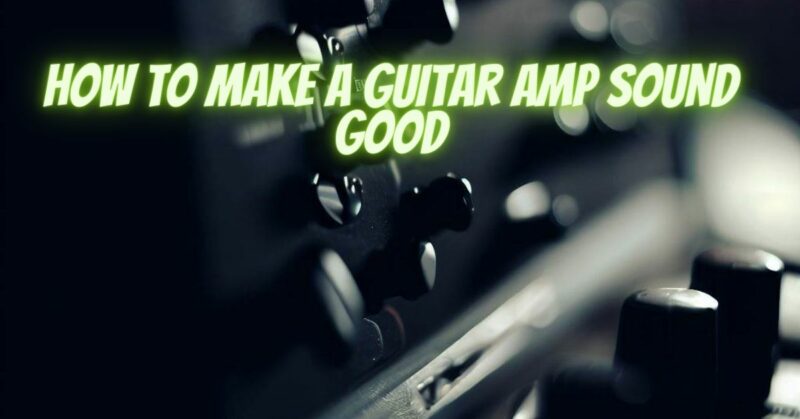A guitar amplifier is an essential tool for any guitarist, whether you’re a beginner or a seasoned musician. It’s not just about amplifying your sound; it’s about shaping and enhancing your guitar’s tone. To get the best sound from your amplifier, you’ll need to optimize its settings and understand how different factors affect your tone. In this comprehensive guide, we’ll explore tips and techniques to help you achieve the optimal sound quality from your guitar amplifier.
- Start with a Clean Slate:
Before diving into the fine-tuning, reset all the amplifier’s settings to their neutral or “flat” positions. This ensures you’re working from a baseline and can make more accurate adjustments.
- Understand Your Amp’s Controls:
Familiarize yourself with your amplifier’s controls. These typically include knobs for gain, volume, EQ (equalization), and sometimes reverb and other effects. Knowing what each knob does is crucial for achieving your desired sound.
- Adjust the Gain/Overdrive:
The gain control affects how much distortion or overdrive your amplifier produces. Lower settings provide cleaner tones, while higher settings yield more distortion. Experiment with different gain levels to find the right amount of crunch for your style.
- Tweak the EQ Settings:
Your amplifier’s EQ knobs (bass, midrange, and treble) allow you to shape your tone. Start with all knobs at the 12 o’clock position and make subtle adjustments from there. Boosting the bass adds warmth, midrange enhances presence, and treble increases brightness. Fine-tune to match your guitar and playing style.
- Consider Your Guitar’s Tone Knobs:
Don’t forget to adjust your guitar’s tone knobs. These can complement the amplifier’s EQ settings. Rolling off the guitar’s tone knob slightly can create a warmer, mellower sound, while turning it up adds brightness.
- Experiment with Speaker Placement:
The placement of your amplifier can impact the sound. Elevating it or angling it differently can affect the way sound waves interact with your surroundings. Try different positions to find the sweet spot.
- Use Pedals and Effects Sparingly:
While effects pedals can enhance your sound, they can also muddy it if overused. Start with a clean signal and add effects gradually. Use effects to complement your sound rather than dominate it.
- Mind Your Volume:
Adjust your amplifier’s volume to suit the context. Lower volumes can provide a clean, bedroom-friendly sound, while cranking it up offers more natural tube saturation and sustain. Be mindful of your surroundings and the needs of your audience.
- Consider the Room Acoustics:
The room you’re playing in can have a significant impact on your amplifier’s sound. Rooms with different sizes and shapes can emphasize or dampen certain frequencies. Adjust your EQ accordingly when changing venues.
- Regular Maintenance:
Keep your amplifier in good working condition. Clean the knobs, jacks, and switches regularly. Check for loose connections or worn-out tubes, and replace them as needed.
- Experiment and Trust Your Ears:
The most critical tip is to experiment and trust your ears. Sound is subjective, and what sounds good to you is what matters most. Spend time tweaking settings, playing different styles, and honing in on the sound that resonates with you.
Optimizing the sound quality of your guitar amplifier is a journey that combines technical knowledge with artistic expression. By understanding your amp’s controls, experimenting with settings, and considering the acoustics of your environment, you can unlock a world of tonal possibilities. Remember that finding your ideal sound is a personal quest, so trust your ears and enjoy the process of crafting your unique guitar tone. Whether you’re a bedroom guitarist or a stage performer, a well-tuned amplifier can elevate your playing and bring your music to life.


